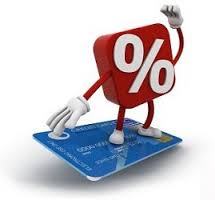 APR. That three-letter acronym looks so simple, but in the world of credit cards, it isn't. APR. That three-letter acronym looks so simple, but in the world of credit cards, it isn't.
The basic definition of an APR: It's an annual percentage rate of interest a credit card holder will be charged on all or a portion of the balance if the full amount isn't paid on or before the due date.
Woman holding credit card © sixninepixels/Shutterstock.com
Beyond that, greater complexities lie.
Here's a summary of what you need to know:
One credit card, multiple APRs
Most credit cards involve several different APRs. For instance, an "introductory" rate might apply as a special offer on a brand-new card while a "promotional" rate might apply to a balance that was transferred from one credit card to another, says Rich Bialek, a credit card industry expert and CEO of Bialek Group, a consultancy for financial services companies in Wheaton, Ill.
Different APRs also may apply to different types of transactions. For example, a cash advance typically would involve a higher APR than a retail purchase because the card company doesn't earn a merchant fee on a cash advance, and an advance is viewed as a riskier transaction, Bialek says.
Lower credit score, higher APR
The primary APR on most credit card transactions is based largely on the credit card holder's credit score, which includes the payment history on that particular card as well as other forms of credit. A lower credit score almost always means a higher APR.
Check your credit score for free at myBankrate.
APR includes interest, not fees
The APR is only one component of the cost of a credit card because cards typically entail various other fees as well. The card issuer doesn't know in advance which or how many fees the cardholder will incur, so it's impossible for that cost to be included in the APR. (Some APRs include the annual fee, if there is one.)
Consider the balance transfer fee, which results in a higher cost of credit than the APR stated on the balance transfer offer. A transfer APR of 2.9 percent might look attractive, but add on an upfront fee of, say, 3 percent, and that 2.9 percent isn't as low as it seems.
Moreover, most balance-transfer offers have an expiration date, after which a higher APR rate will be applied to any unpaid balance. New charges also may have a much higher APR, says Patricia Hasson, executive director of the nonprofit Consumer Credit Counseling Service of Delaware Valley in Philadelphia.
"If you do a balance transfer because it makes financial sense, I would highly encourage you to make sure you understand when the term expires and pay it off prior to the end of the term," she says. "And don't use that card actively for other purchases."
APRs are variable rates
The federal Credit Card Accountability, Responsibility and Disclosure Act, or Credit CARD Act, makes it more difficult for credit card issuers to increase APRs. However, the APR on an existing balance can be raised if a promotional rate ends, an underlying market rate increases or the cardholder misses a payment by more than 60 days. Most rate increases now require 45 days' notice.
TOP LOW INTEREST
The best low interest credit cards for you may be a click away. Check out card offers from our Bankrate.com partners.
Rate reductions are rare
Consumers have three avenues to get a lower APR on a credit card balance.
The first option is to call the issuer, perhaps making reference to other, better offers, and ask outright for a lower rate.
"It's a simple phone call, and the worst they can say is no," Hasson says.
The second option is a formal debt management program, in which the issuer allows a consumer who is overwhelmed by debts to commit to regular payments at a lower APR with the goal of paying off the balance.
The third option is a hardship plan, in which the issuer lets a consumer who has suffered a financial setback pay off the balance at a reduced APR.
A debt management plan may be set up with the help of a credit counseling agency while a hardship plan is usually offered by the credit card company.
Either option may trigger closure of the account, which could harm the consumer's credit score, depending on how the issuer reports that event to the credit bureaus.
"If they are giving you a break, they aren't going to let you incur additional debt," Hasson says.
Pay it off
Consumers who pay the full balance on their credit cards on time every month can ignore APRs. Since they don't owe any revolving debt, they don't have to pay any interest.
"The only caveat," Bialek says, "would be if you missed (a payment) one month, and then (interest) would be charged."
|